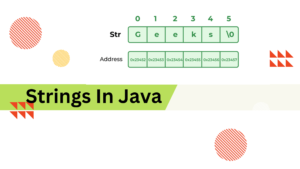Java Operators
Operators are used to perform different operations on variables and values. In Java operators can be divided into the following groups.
- Arithmetic Operators
- Logical Operators
- Assignment Operators
- Comparison Operators
If you’re new to Java, our Do My Java Homework Help and Java Homework Help give full support to boost your grades and knowledge.

(1)Arithmetic Operators in Java Operators
Arithmetic operators are used to perform arithmetic operations on variables and data.
| Operator | Name | Description | Example |
|---|---|---|---|
| + | Addition | It adds to values | x+y |
| * | Multiplication | It multiplies to values | x*y |
| - | Subtraction | It subtracts one value from other | x-y |
| / | Division | Divides on value by another one | x+y |
| % | Modulus | Return the Divion Reminder | x%y |
+ Operator example

Explanation:
| Code | Explanation |
|---|---|
| int x =12; | Declare variable name x with data type int and store 12 inside it |
| int y =10; | Declare variable name y with data type int and store 10 inside it. |
| int result= x+y; | Adding value present inside x and y and the sum will be saved inside variable name result having data type int. |
| System.out.println(result); | System.out.println() is the function which take argument name result which is 22 and print on the console. |
* Operator example
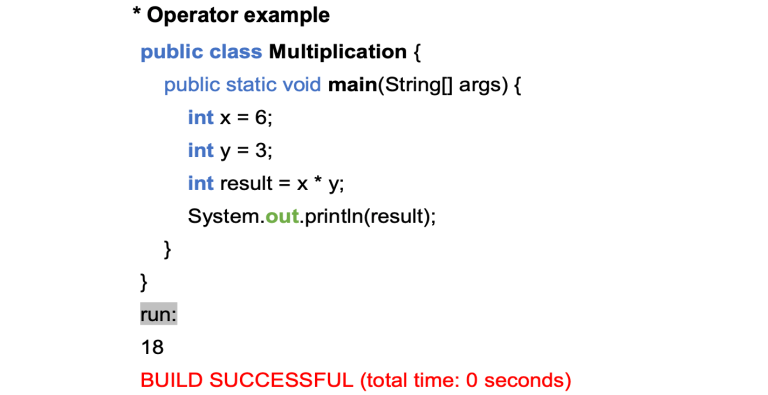
Explanation:
| Code | Explanation |
|---|---|
| int x =6 | Declare variable name x with data type int and store 6 inside it. |
| int y =3; | Declare variable name y with data type int and store 3 inside it. |
| int result= x*y; | Multiply value present inside x and y and the product will be saved inside variable name result having data type int. |
| System.out.println(result); | System.out.println() is the function which take argument name result which is 18 and print on the console. |
- Operator example

Explanation:
| Code | Explanation |
|---|---|
| int x =15 | Declare variable name x with data type int and store 15 inside it. |
| int y =5; | Declare variable name y with data type int and store 5 inside it. |
| int result= x-y; | Subtract y from x and result will be saved inside variable name result having data type int |
| System.out.println(result); | System.out.println() is the function which take argument name result which is 10 and print on the console. |
/ Operator example

Explanation:
| Code | Explanation |
|---|---|
| int x =20; | Declare variable name x with data type int and store 20 inside it. |
| int y =5; | Declare variable name y with data type int and store 5 inside it. |
| int result= x/y; | Divide x with y and result will be saved inside variable name result having data type int |
| System.out.println(result); | System.out.println() is the function which take argument name result which is 4 and print on the console. |
% Operator example

Explanation:
| Code | Explanation |
|---|---|
| int x =22; | Declare variable name x with data type int and store 22 inside it. |
| int y =5; | Declare variable name y with data type int and store 5 inside it. |
| int result= x%y; | Module x with y and reminder will be saved inside variable name result having data type int |
| System.out.println(result); | System.out.println() is the function which take argument name result which is 2 and print on the console. |
(2)Logical Operators in Java Operators
Logical operators are used to determine the logic between variables or values:
| Operator | Name | Description | Example |
|---|---|---|---|
| && | Logical and | Returns true if both statements are true | y > 3 && y< 100 |
| || | Logical or | Returns true if one of the statements is true | x > 15 || x < 10 |
| ! | Logical not | Reverse the result, returns false if the result is true | !(x > 5 && x < 20) |
&& Operator
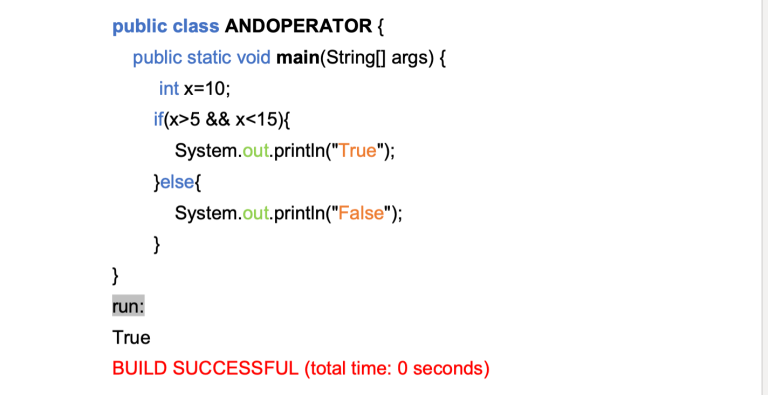
Explanation:
| Code | Explanation |
|---|---|
| int x =10; | Declare variable name x with data type int and store 10 inside it. Declare variable name y with data type int and store 5 inside it. |
| if(x>5 && x<15){ | Checking and condition, if x is greater than 5 and less than 15 which is true as x contain 10 which is greater then 5 and less then 15, so here && condition is true. |
| System.out.println("True"); | As && condition is true so here True will be printed on the Screen. |
| System.out.println("False"); | If && condition is false then False will be printed on the Screen. |
|| Operator
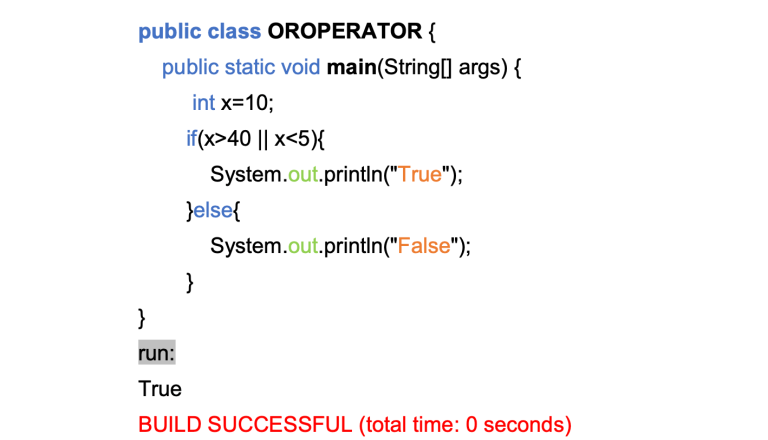
| Code | Explanation |
|---|---|
| int x =10; | Declare variable name x with data type int and store 10 inside it. Declare variable name y with data type int and store 5 inside it. |
| if(x>40 || x<5) | Checking logically or condition, if x is greater than 40 or x is less than 5 which is false as x contain 10 which is less than 40 and greater than 5, so here || condition is false. |
| System.out.println("False"); | As || condition is false so here False will be printed on the Screen. |
| System.out.println("True"); | If || condition is true then True will be printed on the Screen. |
! Operator

Explanation:
| Code | Explanation |
|---|---|
| int x =50; | Declare variable name x with data type int and store 50 inside it.Declare variable name y with data type int and store 5 inside it. |
| if(!(x>40)) | Checking logically not condition, if x is greater than 40 is true because x contain 50 now as we using logical not ! operator so it’s return false |
| System.out.println("False"); | As ! condition return false because x>40 return true, so False will be printed on the screen. |
| System.out.println("True"); | If x>40 return false than ! operator returns true and True will be printed on the screen. |
(3)Assignment Operators in Java Operators
Assignment operators are used to assign values to variables.
| Operator | Example | Equal To |
|---|---|---|
| = | x=10 | x=10 |
| += | x+=4 | x=x+4 |
| *= | x *=4 | x=x*4 |
| -= | x-=6 | x=x-6 |
| /= | x /=2 | x = x/2 |
| %= | x%2 | x=x%2 |
= Operator

Explanation:
| Code | Description |
|---|---|
| int x =50; | = Operate assign the value to x which is 50 |
| System.out.println(x); | System.out.println() is the function which take argument name x which contain value 50 and print on the console. |
+= Operator

Explanation:
| Code | Description |
|---|---|
| int x =50; | = Operate assign the value to x which is 50 |
| x+=4 | x+=4 is equal to x=x+4 so as x=50 and x=50+4, so now x contains 54. |
| System.out.println(x); | System.out.println() is the function which take argument name x which contain value 54 and print on the console. |
*= Operator

Explanation:
| Code | Description |
|---|---|
| int x =50; | = Operate assign the value to x which is 50 |
| x*=4 | x*=4 is equal to x=x*4 so as x=50 and x=50*4, so now x contains 200. |
| System.out.println(x); | System.out.println() is the function which take argument name x which contain value 200 and print on the console. |
-= Operator

Explanation:
| Code | Description |
|---|---|
| int x =50; | = Operate assign the value to x which is 50 |
| x-=4 | x-=4 is equal to x=x-4 so as x=50 and x=50-4, so now x contains 46. |
| System.out.println(x); | System.out.println() is the function which take argument name x which contain value 46 and print on the console. |
/= Operator

Explanation:
| Code | Description |
|---|---|
| int x =50; | = Operate assign the value to x which is 50 |
| x/=2 | x/=2 is equal to x=x/2 so as x=50 and x=50/2, so now x contains 25. |
| System.out.println(x); | System.out.println() is the function which take argument name x which contain value 25 and print on the console. |
%= Operator

Explanation:
| Code | Description |
|---|---|
| int x =23; | = Operate assign the value to x which is 23 |
| x%=2 | x%=2 is equal to x=x%2 so as x=23 and x=23%2, so x contains 1 as the remainder is 1. |
| System.out.println(x); | System.out.println() is the function which take argument name x which contain value 1 and print on the console. |
(4)Comparison Operators in Java Operators
Comparison operators are used to compare two values stored inside variables.
Following comparison operators are used in java language.
| Operator | Name | Description | Example |
|---|---|---|---|
| == | Equal to | Checking value stored inside x variable is equal to value stored inside variable y. | x == y |
| != | Not equal to | Checking value stored inside x is not equal to value stored inside variable y. | x != y |
| > | Greater than | Checking value stored inside x is greater than value stored inside variable y. | x > y |
| < | Less than | Checking value stored inside x is less then value stored inside variable y. | x < y |
| >= | Greater Than or equal to | Checking value stored inside x is equal to or greater than to value stored inside variable y. | x >= y |
| <= | Less than or equal to | Checking value stored inside x is less than or equal to value stored inside variable y. | x <= y |
== Operator
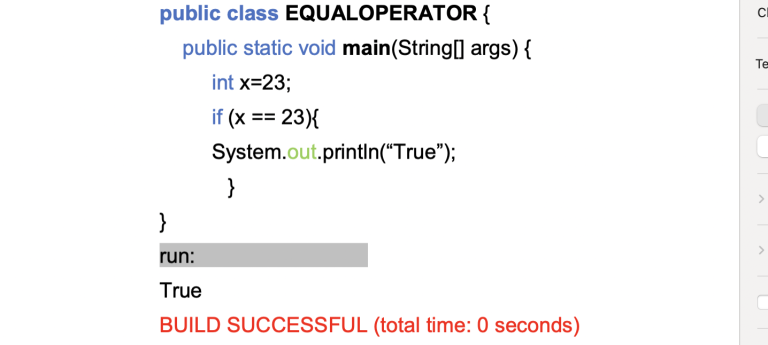
| Code | Description |
|---|---|
| int x =23; | Declare variable name x with data type int and store 23 inside it. |
| If (x == 23) | == Operator checking whether value of x is equal to 23 or not which is true |
| System.out.println(“True”); | System.out.println() function print the True on the screen because if( x == 23) condition is true. |
!= Operator

Explanation:
| Code | Description |
|---|---|
| int x =30; | Declare variable name x with data type int and store 30 inside it. |
| If (x != 25) | != Operator checking whether value of x is not equal to 25 which is true |
| System.out.println(“True”); | System.out.println() function print the True on the screen because if( x != 25) condition is true. |
> Operator
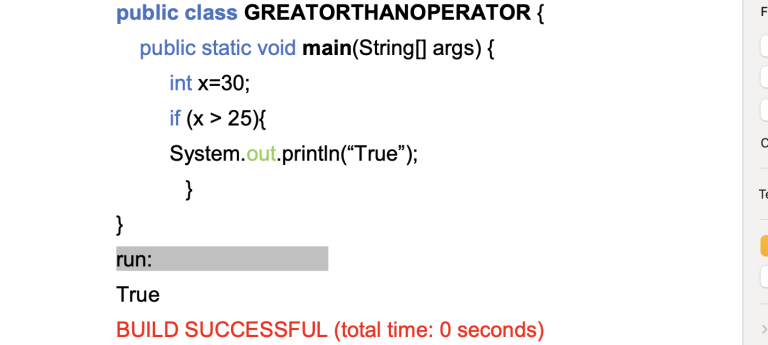
Explanation:
| Code | Description |
|---|---|
| int x =30; | Declare variable name x with data type int and store 30 inside it. |
| If (x > 25) | > Operator checking whether value of x is greater than 25 or not which is true |
| System.out.println(“True”); | System.out.println() function print the True on the screen because ( x > 25) condition is true. |
< Operator
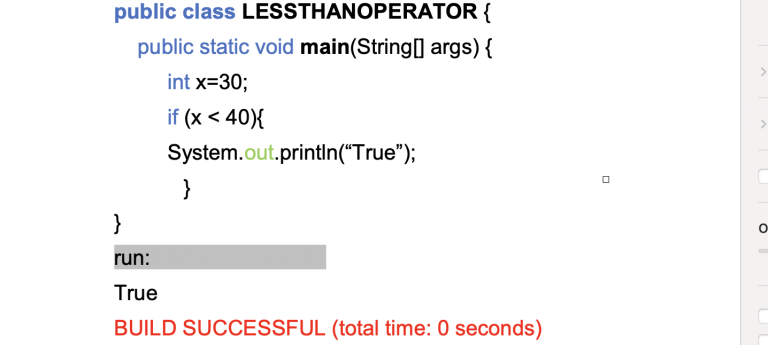
Explanation:
| Code | Description |
|---|---|
| int x =30; | Declare variable name x with data type int and store 30 inside it. |
| If (x < 40) | < Operator checking whether value of x is less than 40 or not which is true |
| System.out.println(“True”); | System.out.println() function print the True on the screen because ( x < 40) condition is true. |
>= Operator

Explanation:
| Code | Description |
|---|---|
| int x =30; | Declare variable name x with data type int and store 30 inside it. |
| If (x => 40) | => Operator checking whether value of x is greater than or equal to 40 which is true |
| System.out.println(“True”); | System.out.println() function print the True on the screen because ( x >= 40) condition is true. |
<= Operator

Explanation:
| Code | Description |
|---|---|
| int x =30; | Declare variable name x with data type int and store 30 inside it. |
| If (x <= 40) | <= Operator checking whether value of x is less than or equal to 40 which is true |
| System.out.println(“True”); | System.out.println() function print the True on the screen because ( x <= 40) condition is true. |
- Arithmetic Operators.
- Unary Operators.
- Assignment Operator.
- Relational Operators.
- Logical Operators.
- Ternary Operator.
- Bitwise Operators.
- Shift Operators.
Operators are used to perform different operations on variables and values.
- Arithmetic Operators
- Logical Operators
- Assignment Operators
- Comparison Operators
Arithmetic operators are used to perform arithmetic operations on variables and data. it is like +,-*,/ and %
This query focuses on operators like ==, !=, <, >, <=, and >= used for comparing values and producing boolean results.
Learners often ask about &&, ||, and ! operators used to create complex boolean expressions and make decisions based on multiple conditions.
This query focuses on operators like =, +=, -=, *=, /=, and %= used to assign values and perform operations simultaneously.

